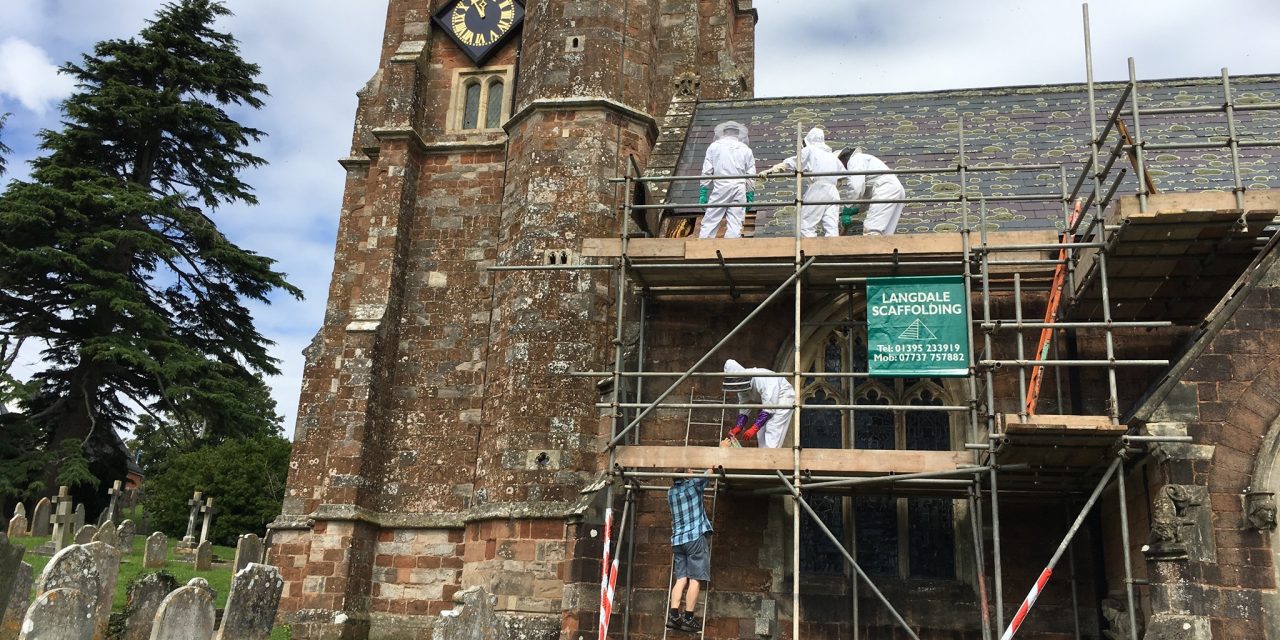HOLY HONEYBEES!
“Those bees have got to be removed from the Church roof – the builders need to make repairs to the top of the walls, and they won’t do it if they’re being attacked by angry bees!” was the statement that greeted me one summer’s morning. Why me – only for the usual simplistic reason that I’m a (very) amateur beekeeper who also happens to attend Lympstone Parish Church. The date was set for late August with our local builders, Jason and Barney, and the scaffolders booked to provide access to the roof. “Oh and by the way there’s a wedding on the weekend before and the weekend after the building repairs, so the work has to be finished and the scaffolding removed before the wedding”.
A swarm of honeybees had adopted a corner of the Church roof about four years ago and seemed very happy there. They also provided me with a nice warm feeling whenever I went into our village Church on a sunny day and could see them busily flying in and out – feeding their young and building up their honey stores. As these bees were the most regular attendees to our Church, never missed a single Service, attended all the Wedding and Christening celebrations, commiserated at the Funerals, and didn’t even protest during the bell ringing practice sessions, they must represent the closest thing to Holy Honeybees in the area!
A couple of other amateur beekeepers in our village, Rosemary and Ed, kindly offered to come and help and on a hot sunny Monday in late August, the scaffolders arrived first thing and erected the scaffolding. The builders, Jason, Barney and Geoff, donned our beesuits, and went up to the roof to remove the slates, cladding and then the underlying woodwork to eventually expose the comb and what is typically about 60,000 honeybees in a colony.
Now beekeeping theory tells us that one simply removes the comb containing young bees, hopefully the Queen, and fits it into an empty hive placed close to their normal entrance (which should take an hour or two at most).One then leaves the bees to follow their Queen and comb into the new home during the remainder of the day. However these bees had completely failed to read the Beekeeping text books and resolutely refused to follow the comb into their intended new home. Instead they climbed further up the inside of the roof. The scheduled plan of that evening moving the hive to a new home several miles away had to be abandoned and people were starting to get a little tense thinking about the building work still required – and the wedding scheduled for the following Saturday.
The next day more tiles were removed to expose the bees, but attempts to find and scoop the Queen into the hive also failed miserably. We spent several hours trying different ideas during which numerous passers-by stopped to enquire about the strange sight of three figures on the Church roof garbed from head to toe in white clothing and surrounded by clouds of smoke and irritated honeybees. Our builders, at a safe distance, amused themselves by telling people to not be too concerned – it was only a minor nuclear incident! By mid afternoon of the second day, when we were at the point of giving up, more smoking of the bees resulted in them getting so fed up with these bungling beekeepers that they suddenly swarmed out of the roof and into a nearby bush in the Churchyard – from where they could be easily collected. So the poor things had suffered two days of invasion of their home, removal of all their hard-earned comb, and no food. The bees had remained incredibly well behaved and tolerant during their removal despite the provocations – obviously some of the Christian messages had been well received! They were finally moved into a new hive on the Wednesday morning when they gulped down the prepared feed in record time. Assuming the Queen and her Workers accept their new hive and stay as well behaved as they were during the removal, their hive will be moved back to a Lympstone garden in the Spring.
Basil Strickland

